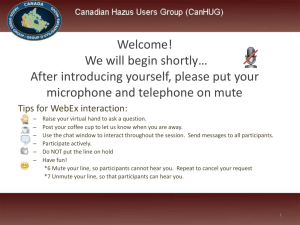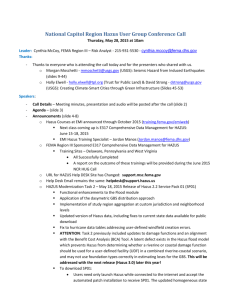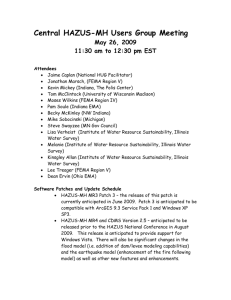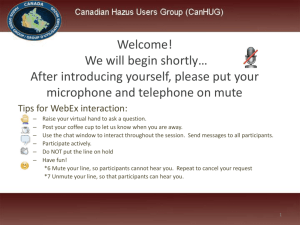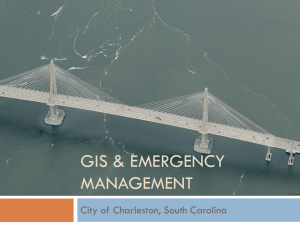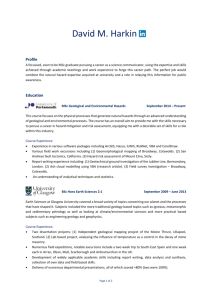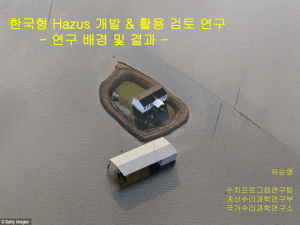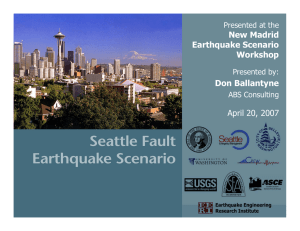HAZUS Modeling for the 1906 San Francisco Earthquake Scenario: Lessons Learned &
advertisement
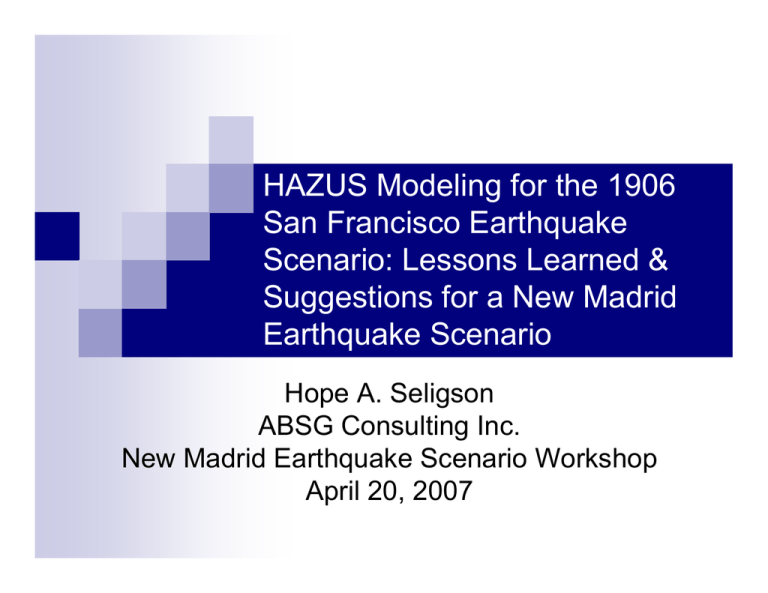
HAZUS Modeling for the 1906 San Francisco Earthquake Scenario: Lessons Learned & Suggestions for a New Madrid Earthquake Scenario Hope A. Seligson ABSG Consulting Inc. New Madrid Earthquake Scenario Workshop April 20, 2007 Today’s Focus: Brief HAZUS overview Use of HAZUS for 1906 EQ Scenario Challenges & Lessons Learned Suggestions for HAZUS implementation as part of a New Madrid Earthquake Scenario Overview of HAZUS (Hazards US) Software Standardized, nationally applicable earthquake, flood and wind loss estimation methodologies. Developed by FEMA, under a cooperative agreement with NIBS (see http://nibs.org/hazusweb/ and http://www.fema.gov/plan/prevent/hazus/). Uses PC-based Geographic Information System (GIS) software, ArcGIS (Requires installation of ArcGIS 9.1, ArcGIS 9.1 Service Pack 1, and Spatial Analyst 9.x for flood modeling) HAZUS is distributed to users free of charge Default data provided for “out of the box” analysis What does HAZUS do? Estimates physical damage in EQ/Flood/Hurricane to: Buildings and their contents Essential facilities (including hospitals, schools, etc.) Transportation lifelines (e.g., Bridges) Utility lifelines (e.g., electric power, water systems) Assesses how populations might be affected Shelter needs Casualties (EQ only) Power and water outage (EQ only) HAZUS’ Levels of Analysis Opportunities exist to improve HAZUS loss estimates by improving Level 2 input data Level 1 Level 3 Input data hazard specific Combinations of local and default hazard, building, and damage data Default hazard, inventory, and damage information Required User Effort and Sophistication Epicenter Location and Magnitude M 8.0 GIS Based Attenuation Model + EARTHQUAKE LOSS ESTIMATION USING HAZUS (Courtesy S. McAfee, CA OES) Soil Maps x + l Mode Building Inventory Maps + Ground Shaking Maps Demographic Maps Mo del Direct and Indirect Losses Casualties/ Shelter Needs Estimation HAZUS-MH Default Inventory Data Default inventory data includes: “General building stock” - proxy representation of all buildings in the U.S. Essential facilities* – hospitals, schools, etc. Transportation lifelines* – highway, railway, etc. Utility Lifelines* – water, power, gas, etc. Demographics Economic values * In some cases, default data may be limited or unavailable Building Inventory Data in HAZUS Exposure data: total building square footage & dollars, by occupancy (33), and census tract for entire US. (Æ “proxy” data) Mapping scheme data: for each occupancy, provides a % distribution across structural or “model building” types - e.g., x% of “Offices” are “Steel” (general) and y% of these are “mid-rise Braced Steel Frame, designed to moderate seismic design codes” (detailed). 36 HAZUS Model Building Types Distributions further characterized by seismic design level & quality: -PC – pre-seismic design -LC – low seismic design level, code quality -LS - low, superior quality -MC – moderate, code -MS – moderate, superior -HC – high, code -HS – high, superior MBT W1 W2 S1L S1M S1H S2L S2M S2H S3 S4L S4M S4H S5L S5M S5H C1L C1M C1H C2L C2M C2H C3L C3M C3H PC1 PC2L PC2M PC2H RM1L RM2M RM2L RM2M RM2H URML URMM MH Height Low Low Low Mid High Low Mid High Low Low Mid High Low Mid High Low Mid High Low Mid High Low Mid High Low Low Mid High Low Mid Low Mid High Low Mid Low Description Wood, Light Frame (< 5,000 sq. ft.) Wood, Commercial and Industrial (>5,000 sq. ft.) Steel Moment Frame Steel Braced Frame Steel Light Frame Steel Frame with Cast-in-Place Concrete Shear Walls Steel Frame with Unreinforced Masonry Infill Walls Concrete Moment Frame Concrete Shear Walls Concrete Frame with Unreinforced Masonry Infill Walls Precast Concrete Tilt-Up Walls Precast Concrete Frames with Concrete Shear Walls Reinforced Masonry Bearing Walls with Wood or Metal Deck Diaphragms Reinforced Masonry Bearing Walls with Precast Concrete Diaphragms Unreinforced Masonry Bearing Walls Mobile Homes HAZUS Data Enhancement Guidelines Guidelines & Tools developed to help users. Tested in CA for LA (2.3M records) and SLO (105k records) Counties. Guidelines covered replacement of default inventory data (SQFT, $) using real-world data (e.g., Assessor’s data). Can be time-consuming, expensive Assessed efficacy using 2003 San Simeon Available on-line at: http://www.hazus.org/BAHUG/Reference_Info.htm Earthquake event. San Luis Obispo County Comparison to HAZUS default General Occupancy Residential Commercial Industrial All Occupancies Difference Between Assessor’s Data And HAZUS Default Data (Relative To Assessor’s Data) Number of Buildings Square Footage 29% 28% -76% 240% 18% 1725% 23% 42% ÆHAZUS default data may overestimate exposure (sq ft) in smaller, less urban counties. Los Angeles Co. - Comparison to HAZUS default General Occupancy Residential Commercial Industrial All Occupancies Difference Between Assessor’s Data And HAZUS Default Data (Relative To Assessor’s Data) Number of Buildings Square Footage 18% 6% -68% -46% -81% -55% 10% -13% Æ HAZUS default data may underestimate non-residential exposure (sq ft) in large, urban Counties. Impact of Improvement on EQ loss Estimates: 2003 San Simeon EQ Loss Comparison (Relative to Observed Losses) Economic Losses Building Damage Total Direct Economic Losses Default HAZUS Analysis Overestimated by ~73% Overestimated by 50% HAZUS Analysis w/ “Enhanced Inventory Data” within 20% within 3% 1906 EQ Scenario – HAZUS efforts Multidisciplinary team – structural/earthquake engineer, loss estimation modeler, HAZUS software developer. (Also received input from insurance risk modelers.) Worked closely with USGS and others focusing on seismic hazard and ground failure modeling. Large study area (19 counties) required approach making use of available regional data (e.g., county specific data collection not possible in the limited time). Figure 2. Map of study region showing 1-second spectral acceleration ground motions for a magnitude M7.9 earthquake on the San Andreas Fault (near San Francisco) 1906 EQ Scenario HAZUS Results M7.9 EQ on the N. San Andreas Fault 19 County Study Area, w/ > 10M people and ~ $1.5 trillion of building and contents 800–3,400 deaths $90–120 billion in property loss 7,000–10,000 commercial buildings closed due to serious damage 160,000–250,000 households displaced. Æ See: “When the Big One Strikes Again— Estimated Losses due to a Repeat of the 1906 San Francisco Earthquake”, C.A. Kircher, H.A. Seligson, J. Bouabid, and G.C. Morrow, Earthquake Spectra, Volume 22, No. S2, April 2006, and http://www.1906eqconf.org/mediadocs/BigonestrikesReport.pdf 1906 EQ Scenario HAZUS Enhancements Development of 11 custom “mapping schemes” that better reflect the relationship of building occupancy to model building type, including age/design level & height. Adjustment of the square footage of the most seismically vulnerable model building types (e.g., URM, NDCF) to better reflect actual square footage of these building types when such information (e.g., mitigation) is known. Adjustment of building exposure to better reflect actual exposure (based on information developed by RMS for the insurance industry) Adjustment of “time-of-day” populations to better reflect study region population. Figure 4. Map of study region showing 19 counties and areas of greater and lesser building density (i.e., total building square footage normalized by census tract area) Figure 6. Map of study region showing 19 counties and areas of older and newer buildings (based on age of residential buildings) Figure 9. Map of study region showing direct economic loss ratios by census tract for all buildings based on magnitude M7.9 ground motions Challenges? Required a Multi-disciplinary team: Structural Engineer, Loss Estimation Modeler & HAZUS Software Developer Timing – large effort, short schedule. Coordination – close coordination w/ USGS etc. was necessary. Iterations on ground motion modeling were required, along with calibration using Loma Prieta data. Effort was not able to include lifeline or essential facilities data enhancements Long Term Benefit EQ Anniversary Conference and Campaign raised awareness of EQ risk in Bay Area. The HAZUS loss estimates received significant press coverage. The HAZUS loss estimates were subsequently used for emergency response exercises and planning. HAZUS study region still in use by CA OES. They have the opportunity to apply the enhanced analysis for other EQ events. Potential HAZUS Improvements to be made for a New Madrid Scenario Earthquake Incorporation of custom ground motion and ground failure data developed by local and regional experts. Building inventory mapping scheme updates Lifeline & essential facilities data updates Building inventory data updates Approach for building inventory mapping scheme updates for a NMSE? Assemble committee of local structural/earthquake engineers to update applicable mapping schemes (general & detailed), including height distribution & design levels. Consider developing multiple mapping schemes, and apply on a census tract-basis using median age data and construction density, if possible. Updated schemes can be entered directly into HAZUS, or behind the scenes. Example “General Mapping Scheme”: MO1 = MO Default Mapping Scheme (based on low seismic design) also available: MO2 = Default Mapping Scheme (based on moderate seismic design) Example “Detailed Mapping Schemes” for Masonry Buildings: RES3F = Large Apts. COM4 = Offices LC = Low seismic design level, Code Quality PC = Precode Essential Facilities Data Updates: Hospital Example Essential Facilities Data – Hospitals (143 in MO, 26 in STL C/C) Hospital Name, AHA ID Number Address, City, Zipcode, State Contact Name, Phone Number (no default data) Year Built, Number of Stories (no default data) Replacement Cost - default: small (<=50beds) = $3.605M, medium (50 – 150 beds) = $7.21M, large (150+ beds) = $14.42M Backup Power (Y/N, default = No) Number of Licensed Beds Latitude/Longitude HAZUS Model Building Type (MO default = PC1, pre-cast concrete tilt-up walls) & Design Level (in MO, 8 MC, 135 are PC) Local conditions: Soil Type (default = D), Liquefaction Susceptibility Category (default = none), Landslide Susceptibility Category (default = none) Groundwater Depth (default = 5 feet) Note: 1 record per facility, not per building Approach for HAZUS Building inventory data updates? Time and budget permitting, consider replacing inventory data (SQFT) with Assessor’s based data where available (e.g., high exposure counties). Also update Exposed Value ($) and Building Count based on updated SQFT. This data can also be used to validate expert opinionbased updated mapping schemes. Æ More complex and time consuming task. Questions? Contact Info Hope Seligson ABSG Consulting Inc. hseligson@absconsulting.com
